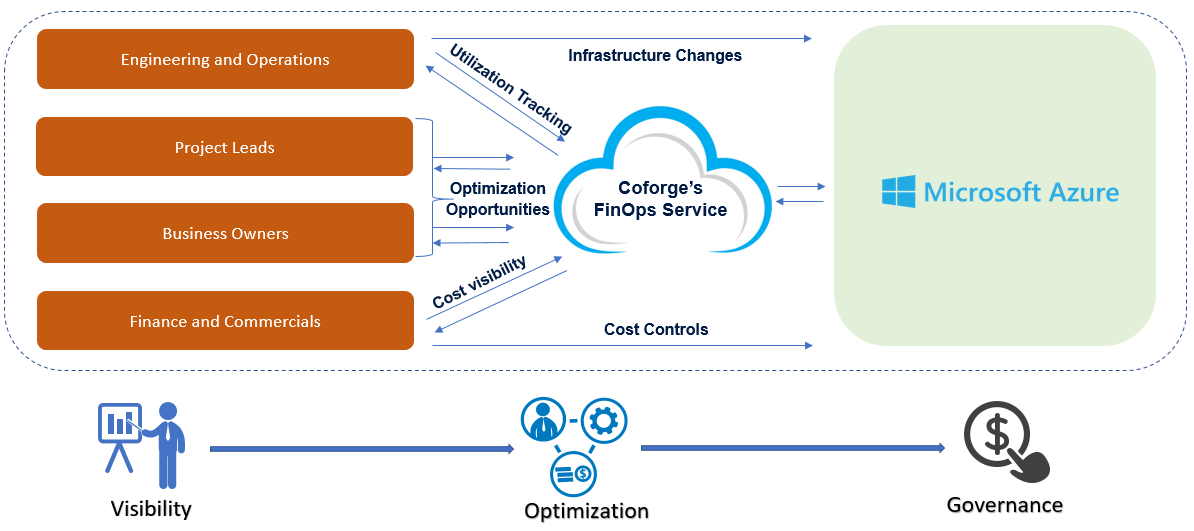Any system which is left unattended for a long time has the potential to move to gradual disorder, and Azure Cloud landscape is no exception to that rule. If Microsoft Azure Cloud subscriptions are left unattended, with little or no governance, they gradually become disorganized, which is called the Entropy of the Cloud.
The impact of Entropy is as follows:
- Lack of Observability, eventually overall control
- Lack of control on the cost
- Periodic spikes in cost
- Reduction in the ROI of Cloud
- Breach of budget on Cloud spends
- Security risks and potential areas of threat
A Case Study
The Scenario
The graph below depicts the critical points of a typical azure cloud spend for a customer.
- The customer started their Azure Cloud journey in January with only Dev/Test workloads on Azure
- The expected cloud spend was about 110-130K USD every month and the projected stable environment was in March
- The cost kept increasing beyond 150K USD
- In September and October, the Infrastructure team started reactive analysis to understand why there was a huge spike in the cost even though no new servers had been added.
- The spike of over 50K USD per month became a genuine reason for concern for everyone in the organization, including the CIO.

The Challenges
While everyone in the team was keen to identify the reasons for the continuous increase in cost, the biggest challenge was identifying the reason for the cost surge and allocating the percentage of the spend to them.
Let’s look at what is visible and what is not visible in a typical cloud spend analysis

Did you know that almost 70% of CIOs and CTOs have claimed that Cloud Cost Management is a genuine area of interest and Cloud Cost Surges and lack of visibility are the biggest roadblocks they see in going all in on the Cloud?
How to Handle the Entropy of Azure Cloud?
Before we decide on how to handle the entropy, we must accept that Cloud Cost may continue to increase even when no new workloads are being added. There could be various reasons for the same. Hence, managing and optimizing the cloud cost is not a one-time but a continuous and a month on month governance.
Take advantage of the tools included in your Azure subscription to get more value from the cloud and implement the financial governance. The recommended azure tools are
- Monitoring Cloud Spend
- Driving organizational accountability
- Optimizing cloud efficiency
Keeping this in mind, there are a few things to follow
During Deployment
- Set Object Life-cycle Management on all our Azure storage accounts, backup and recovery vaults
- Ensure only those Azure storage accounts that need replicated data over the globe are GRS enabled
- Automate log purging, define retention policy and implementation of log stores
- All associated Azure resources should be clubbed together, using tagging or resource groups
- Standard Operating Procedures for resource provisioning and resource deletion should be defined and followed.
- Use Azure Reserved Instances for 24x7x365 workloads
- Automate Auto-start & Auto-stop of Virtual Machines that require to be active only for few hours a day/week.
- Use Azure VM Scale Set for applications with variable demand of Cloud resources.
Ongoing Basis
- Set-up budgets and alerts on all azure subscriptions to that all alert groups are current, and notifications are being sent to the right person.
- Create a Governance Metrics across the organization for pro-active cost management before the billing cycle.
- Periodic utilization review of all resources should be done, any underused or unused resource should be flagged for adequate action
How AdfarTech can help in Managing the Entropy of Cloud?

AdfarTech has defined a robust framework under its Cloud Operations addressing the need of managing and maintaining a stable cloud environment that provides complete cost accountability. We aim to help our customers maximize their ROI on azure cloud with effective management and governance.
